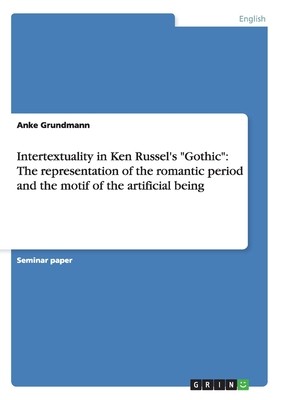
- We will send in 10–14 business days.
- Author: Anke Grundmann
- Publisher: GRIN Verlag
- Year: 2007
- Pages: 30
- ISBN-10: 3638705714
- ISBN-13: 9783638705714
- Format: 14.8 x 21 x 0.2 cm, softcover
- Language: English
- SAVE -10% with code: EXTRA
Reviews
Description
Seminar paper from the year 1998 in the subject English Language and Literature Studies - Literature, grade: 1-, Bielefeld University (Fakultät für Linguistik und Literaturwissenschaft), course: Motivgeschichte/Intertextualität: Mary Shelley's Frankenstein, language: English, abstract: The film Gothic starring Gabriel Byrne (in the role of Lord Byron), Julian Sands (Percy Bysshe Shelley), Natasha Richardson (Mary [Wollstonecraft Godwin] Shelley), Myriam Cyr (Claire Clairmont) and Timothy Spall (Dr John Polidori) and directed by Ken Russell was made in 1986. It is difficult to decide whether the film is a horror film or a period film because it contains elements of both genres. The viewer's judgement depends on his or her previous knowledge of the life of the characters. If the viewer does not recognize the relation between the elements and statements in the film and texts written by and about the protagonists he or she will feel Gothic to be mainly a horror film. In other words intertextuality plays an important role in Gothic. Therefore, the aim of this term paper is to analyze the intertextual relations between the film and various texts. Since there are many different concepts concerning intertextuality I will mostly focus on Julia Kristeva's idea of intertextuality in the first chapter. In the second chapter the literary historical aspects of Gothic will be examined. The film is set in 1816, i.e. in the second phase of the Romantic period. I will analyze how Ken Russell represents some of the characteristics of the Romantic period in his film. Among others, a motif in the film is the artificial being and the creation of an artificial being respectively. This motif is also the topic of Mary Shelley's novel Frankenstein. The third chapter deals on the one hand with the question how the motif "artificial being" is represented in Ken Russell's film and on the other hand in how far this parallels the novel Frankenstein and Gothic. Finally, the aim of the
EXTRA 10 % discount with code: EXTRA
The promotion ends in 6d.06:49:38
The discount code is valid when purchasing from 10 €. Discounts do not stack.
- Author: Anke Grundmann
- Publisher: GRIN Verlag
- Year: 2007
- Pages: 30
- ISBN-10: 3638705714
- ISBN-13: 9783638705714
- Format: 14.8 x 21 x 0.2 cm, softcover
- Language: English English
Seminar paper from the year 1998 in the subject English Language and Literature Studies - Literature, grade: 1-, Bielefeld University (Fakultät für Linguistik und Literaturwissenschaft), course: Motivgeschichte/Intertextualität: Mary Shelley's Frankenstein, language: English, abstract: The film Gothic starring Gabriel Byrne (in the role of Lord Byron), Julian Sands (Percy Bysshe Shelley), Natasha Richardson (Mary [Wollstonecraft Godwin] Shelley), Myriam Cyr (Claire Clairmont) and Timothy Spall (Dr John Polidori) and directed by Ken Russell was made in 1986. It is difficult to decide whether the film is a horror film or a period film because it contains elements of both genres. The viewer's judgement depends on his or her previous knowledge of the life of the characters. If the viewer does not recognize the relation between the elements and statements in the film and texts written by and about the protagonists he or she will feel Gothic to be mainly a horror film. In other words intertextuality plays an important role in Gothic. Therefore, the aim of this term paper is to analyze the intertextual relations between the film and various texts. Since there are many different concepts concerning intertextuality I will mostly focus on Julia Kristeva's idea of intertextuality in the first chapter. In the second chapter the literary historical aspects of Gothic will be examined. The film is set in 1816, i.e. in the second phase of the Romantic period. I will analyze how Ken Russell represents some of the characteristics of the Romantic period in his film. Among others, a motif in the film is the artificial being and the creation of an artificial being respectively. This motif is also the topic of Mary Shelley's novel Frankenstein. The third chapter deals on the one hand with the question how the motif "artificial being" is represented in Ken Russell's film and on the other hand in how far this parallels the novel Frankenstein and Gothic. Finally, the aim of the


Reviews